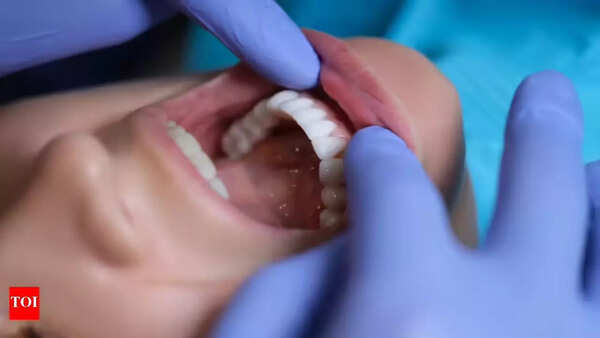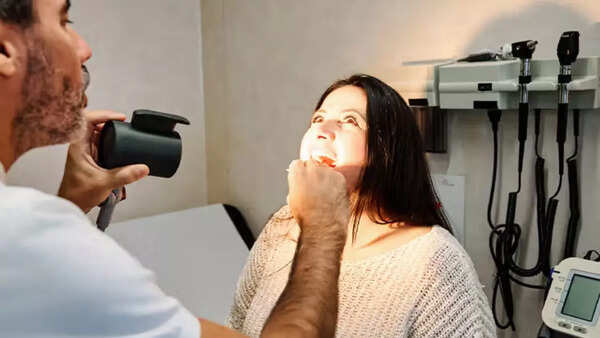Oral cancer, also known as mouth cancer, is a serious condition that develops in the tissues of the oral cavity. This includes areas such as the lips, tongue, gums, inner cheeks, and the roof or floor of the mouth. In some instances, it can also affect the oropharynx, the area at the back of the throat. Often beginning as a painless sore or patch, it can easily go unnoticed in its early stages. Regular dental checkups and self-examinations are crucial for early diagnosis. While it can affect anyone, certain lifestyle factors, such as tobacco and alcohol use, significantly elevate the risk.
Early detection and prompt treatment are vital for improving outcomes and survival rates. Let's explore the signs, symptoms, and prevention strategies related to oral cancer.
Oral cancer is a type of head and neck cancer that originates in the tissues of the oral cavity. This encompasses the lips, tongue, cheeks, gums, the floor and roof of the mouth, and sometimes the oropharynx.
The condition typically manifests as a persistent sore, patch, or lump that doesn't heal, often mistaken for a minor issue initially.
If left untreated, oral cancer can spread to nearby structures, including lymph nodes and other parts of the head and neck, and in advanced cases, to distant organs. Despite its potential severity, oral cancer is highly treatable when diagnosed early.
Oral cancer predominantly affects individuals aged 60 and older, although younger people can also develop it. Statistically, men are twice as likely as women to be diagnosed with the disease. Among different racial groups, white men have a higher incidence rate than Black men. Approximately 11 out of 100,000 individuals will be diagnosed with oral cancer in their lifetime.
This type of cancer is particularly concerning because many of its early symptoms are painless and subtle, which often leads to delayed diagnosis and treatment.

Oral cancer often presents as persistent changes within the mouth that do not resolve. These can include:
Visible Signs:
Sensory and Functional Symptoms:
While these symptoms can resemble other conditions like infections or ulcers, their persistence should raise concern and prompt a medical evaluation.

Performing a monthly self-exam can aid in the early identification of unusual changes in your mouth. Follow these steps:
If you notice anything unusual, it's crucial to consult a healthcare professional immediately.

Oral cancer can significantly impair a person’s ability to speak, chew, swallow, and even breathe, depending on the tumor's location and size. When it affects the oropharynx, it may lead to oropharyngeal cancer, impacting the base of the tongue, soft palate, tonsils, and the back of the throat.
The oral cavity, where oral cancer typically originates, includes:
Oral cancer starts in squamous cells, which are thin, flat cells lining the inside of the mouth. When these cells undergo mutations—usually due to prolonged exposure to carcinogens—they multiply uncontrollably, forming tumors.
Major Risk Factors
According to Healthline reports, approximately 25% of oral cancer cases occur in individuals without any of the above risk factors, emphasizing the importance of regular oral screenings.
Diagnosis typically begins during routine dental or medical exams, with dentists often playing a key role in early detection.
Diagnostic methods include:
Once a lesion is confirmed as cancerous, additional tests are performed to determine the stage, which influences treatment options.
Oral cancer is staged using the TNM system:
Staging helps doctors determine the most effective treatment and estimate the patient’s prognosis.
While not all cases of oral cancer are preventable, the risk can be significantly reduced through:
Life after oral cancer treatment varies. Some patients experience minor changes, while others face long-term impacts on speaking, chewing, and appearance. Support from reconstructive surgery, physical therapy, speech therapy, and mental health counseling may be needed. Ongoing check-ups are essential, as recurrence or secondary cancers are possible.
Older articles
 Former India Selector Blasts Fielding Lapses After Test Defeat; Urges Patience With Team
Former India Selector Blasts Fielding Lapses After Test Defeat; Urges Patience With Team
 Greg Chappell: Rishabh Pant is Revolutionizing Cricket with Unorthodox Style
Greg Chappell: Rishabh Pant is Revolutionizing Cricket with Unorthodox Style
 Optical Illusion Puzzle: Only 1% Can Find All Hidden Animals – Can You?
Optical Illusion Puzzle: Only 1% Can Find All Hidden Animals – Can You?
 Indian Pacer Harshit Rana Released from Squad Ahead of Second England Test Amidst Series Pressure
Indian Pacer Harshit Rana Released from Squad Ahead of Second England Test Amidst Series Pressure
 Vegetarian Powerhouses: 20 Plant-Based Protein Sources That Outperform Eggs
Vegetarian Powerhouses: 20 Plant-Based Protein Sources That Outperform Eggs
 Asia Cup 2025: ACC Reportedly Targets September Start Amid Rising Hopes, Aims for Schedule Release Next Month
Asia Cup 2025: ACC Reportedly Targets September Start Amid Rising Hopes, Aims for Schedule Release Next Month
 Chess Prodigy: Nine-Year-Old Indian Player Secures Draw Against Magnus Carlsen
Chess Prodigy: Nine-Year-Old Indian Player Secures Draw Against Magnus Carlsen
 Prasidh Krishna Eyes Bowling Improvement: Focus on Economy Rate and Length Control During England Tour
Prasidh Krishna Eyes Bowling Improvement: Focus on Economy Rate and Length Control During England Tour
 Mirabai Chanu: Olympic Medalist Reveals Relentless Focus on Training, Weight Control Even During Family Time
Mirabai Chanu: Olympic Medalist Reveals Relentless Focus on Training, Weight Control Even During Family Time
 Smith Eyes Grenada Test Return After Injury Layoff
Smith Eyes Grenada Test Return After Injury Layoff